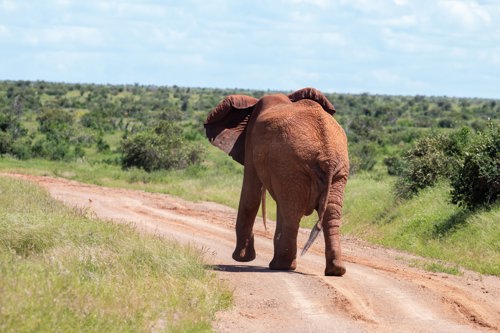Why you want to do a self-drive safari in Tarangire
Attention Elephant lovers! While the Tarangire National Park in Tanzania may not sound all that familiar, during the dry season, this overlooked treasure has the largest concentration of elephants in the world!
Additionally, the park is known for its abundance of baobab trees and beautiful stands of acacia tortilis trees - those flat-topped acacias you'll probably know from films like 'The Lion King' or 'Out of Africa'. As Tarangire is conveniently located near Arusha, it is a wonderful first safari stop on your Tanzania self-drive roadtrip.
Starting to consider a safari in Tarangire National Park? Then keep reading for more information!

The best time to visit Tarangire for a safari
In Tarangire National Park, animal concentration peaks between July and November to early December. During this dry season, Tarangire has the second-highest wildlife concentration of any Tanzanian National Park. From November to May, some of the game leaves the park. Herds of wildebeest and zebra head northwest to the Rift Valley floor and the vast open areas of the Maasai Steppe. Nevertheless, we have visited Tarangire multiple times throughout the year and consistently had a wonderful safari experience.
How to get from Arusha to Tarangire
Tarangire is located 100 km southwest of Arusha, about 7 km off the main Arusha – Dodoma road. The turn-off at Kwa Kuchinja is signposted. The road is tarred and in perfect condition, and the journey from Arusha takes less than 2 hours. Are you a bit nervous about driving in Tanzania? Then, this journey makes an excellent first easy start.
To make the most out of your Tanzania safari experience, we recommend including Tangarire in a 9-day itinerary, adding highlights such as Serengeti, Ngorongoro, and Lake Manyara to your drive:
- Day 1: Arusha
- Day 2: Driving from Arusha to Tarangire (150 km, 2.5 hours)
- Day 3: Tarangire National Park
- Day 4: Driving from Tarangire to Serengeti (260 km, 6 hours)
- Day 5 & 6: Serengeti
- Day 7: Driving from Serengeti to Ngorongoro (140 km, 3.5 hours)
- Day 8: Ngorongoro Crater, then on to Mto Wa Mbu (200 km, 3 hours)
- Day 9: Lake Manyara, then on to Arusha (115 km, 2 hours)
Check out our Northern Safari Circuit Itinerary for more detailed route information and the option to book your 4x4!
Baobabs in Tanzania and Tarangire
For ages, the baobab has been a secret, precious tree to the area's pastoralist tribes because of its multiple purposes. They store massive amounts of water in their swollen stems. Furthermore, the fruit and leaves are used in traditional medicine to treat problems such as fever and kidney disease. You'll find plenty of baobabs scattered throughout Tarangire National Park.
Interesting to know is that the West has also set its sights on the baobab tree. The baobab fruit has just been given EU approval to be used in smoothies and cereal bars. Food marketers have labeled it as the next superfruit; it is reported to have six times more vitamin C than oranges and twice as much calcium as milk. Does anyone fancy a baobab smoothie?
Taking off on your Tarangire safari adventure
Are you ready to rent a car and explore Tarangire National Park on a self-drive trip? Get in contact with our experienced team at Roadtrip Africa to check availability and secure your 4x4 now!